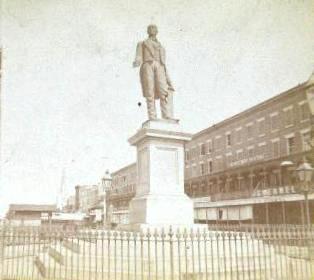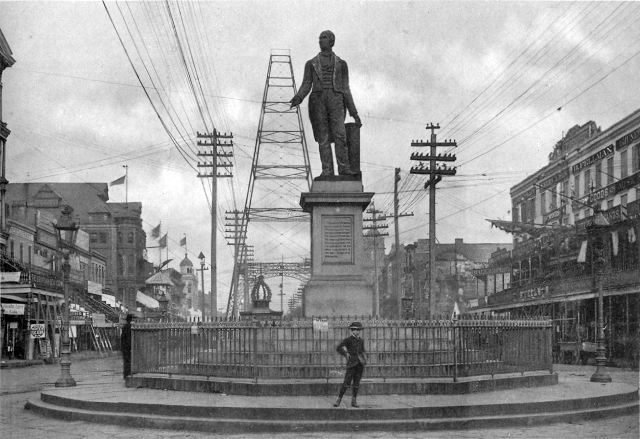


Three closeup views of the Henry Clay statue at the intersection of Canal and St. Charles/Royal Streets, the upper dated 1873, the middle dated 1882, and the bottom dated 1892. The statue is about twelve feet high. Clay is in the act of addressing the U. S. Senate, with his right hand extended in gesture. The view is looking out toward the lake, so Clay is facing the river.
The history of the statue was featured in its inaugural ceremony, held April 12, 1860. The sculptor, Joel T. Hart, gave the oration, in which he included the following (Harper's Weekly, April 28, 1860).
“In the year 1852, a number of public-spirited and patriotic citizens,
desirous of manifesting their veneration for the character and public
services of Henry Clay, formed themselves into a society named the `Clay
Monument Association of New Orleans.' Their object, as their name
indicates, was to erect in this city a suitable monument to the illustrious
man whose memory they designed to honor.
“They determined to erect a bronze statue of Mr. Clay, and they fixed upon
this spot for its location, with the permission of the city authorities.
“On the 12th of April, 1856, the corner-stone of the pedestal was laid
with becoming solemnities. The work of making the statue was intrusted
to Mr. Joel T. Hart, of Kentucky. The Association displayed their good
judgment in committing this important work to a native sculptor, whose
distinguished reputation in the world of Art gave an earnest of its admirable
execution; and who, born by the side of the illustrious patriot, and having
early learned to contemplate his greatness, would bring to the performance of
his grateful task a genius glowing with the enthusiasm of unbounded personal
admiration.” [The scultor/orator wasn't shy about himself, was he?]
“Equally judicious has been the selection of this site for the statue.
In the most frequented thoroughfare of our city—in the very heart of the
metropolis, overlooking the Mississippi, the great avenue of our internal
commerce, and one of the strongest natural bonds of the Union—it stands
conspicuous; a noble and permanent ornament of New Orleans, and a fit
monument of the gratitude and veneration of a free people.”
In the middle picture, some of the signs can be made out on the buildings on the downtown side of Canal (to our right), such as one that says “Music Store.” Note how the electrical wires have taken over the sky by 1892. The big tower in the bottom picture was at the Carondelet/Bourbon intersection. — S. T. Blessing (upper), Lilienthal (middle), Wittemann/Albertype (bottom)


